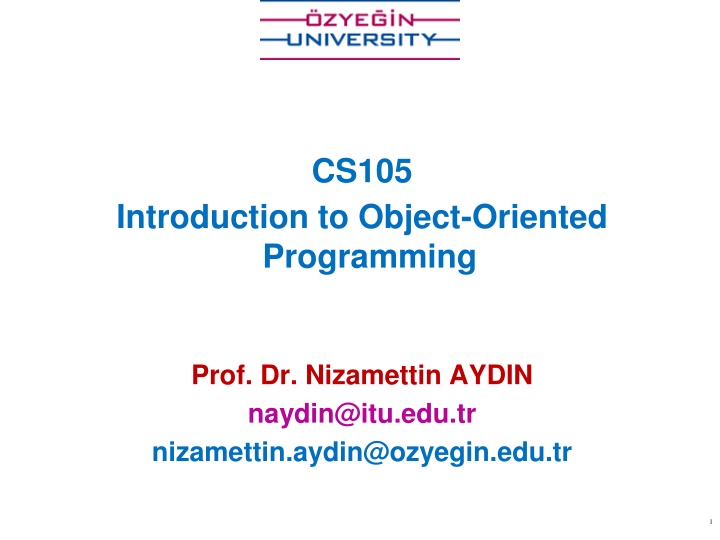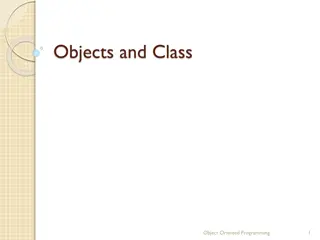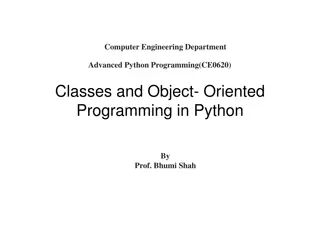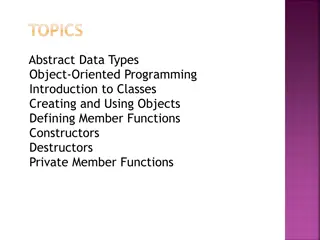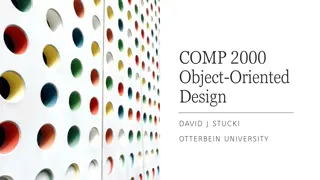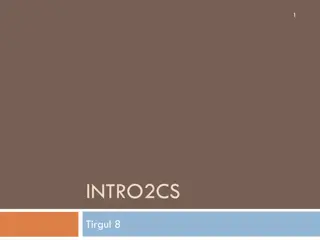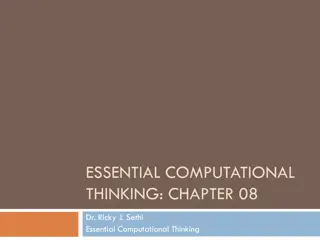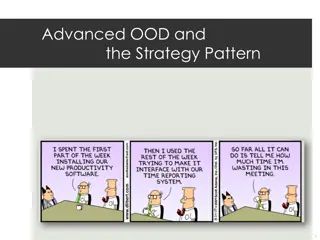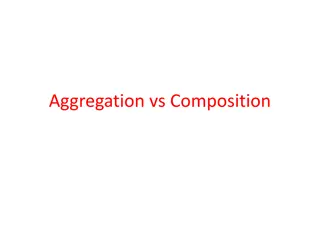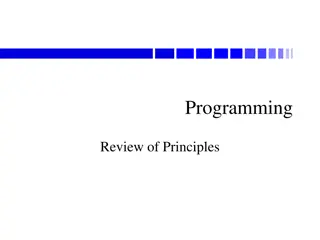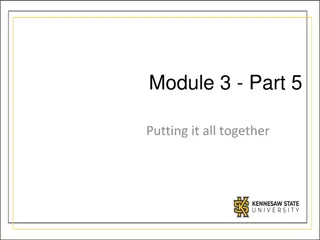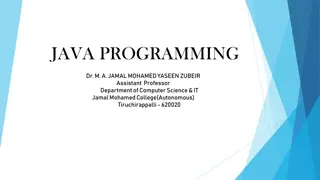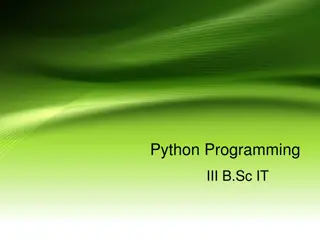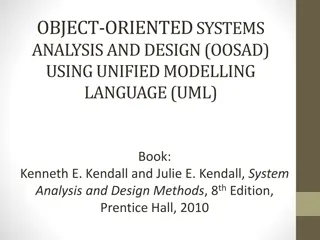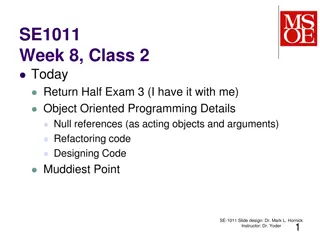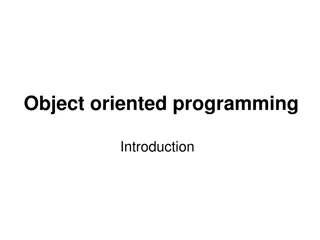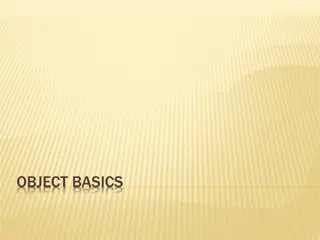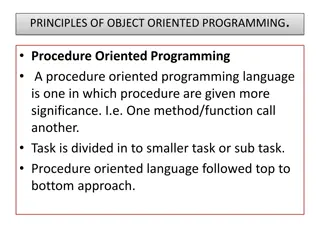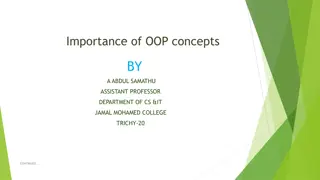Introduction to Object-Oriented Programming
Dive into the fundamentals of object-oriented programming with Professor Dr. Nizamettin Aydin. Explore key concepts and principles to develop a strong foundation in OOP. The course covers encapsulation, inheritance, polymorphism, and more to grasp the essence of OOP paradigms. Enhance your coding skills and learn to design efficient solutions using OOP techniques. Whether you are a beginner or seeking to deepen your understanding, this course offers a comprehensive journey into OOP. Take your programming skills to the next level and unleash the power of OOP in your projects.
Download Presentation

Please find below an Image/Link to download the presentation.
The content on the website is provided AS IS for your information and personal use only. It may not be sold, licensed, or shared on other websites without obtaining consent from the author.If you encounter any issues during the download, it is possible that the publisher has removed the file from their server.
You are allowed to download the files provided on this website for personal or commercial use, subject to the condition that they are used lawfully. All files are the property of their respective owners.
The content on the website is provided AS IS for your information and personal use only. It may not be sold, licensed, or shared on other websites without obtaining consent from the author.
E N D
Presentation Transcript
CS105 Introduction to Object-Oriented Programming Prof. Dr. Nizamettin AYDIN naydin@itu.edu.tr nizamettin.aydin@ozyegin.edu.tr 1
Abstract Classes and Interfaces 2
Outline Shapes Inheritance Abstract Classes Abstract and Concrete Classes Abstract Functions Interface Adapter Class instanceof operator 3
Shapes Let s implement classes for shapes Rectangle Circle etc. What is common in all these shapes? x and y coordinates that hints about the location of the shape. 4
Shapes (x,y) coordinate (x,y) r h (x,y) w In circle we hold an additional radius, in rectangle we have height and width. 5
Inheritance We can have a shape class. Other shapes can inherit from the shape class. Shape Circle Rectangle 6
Sometimes a class should define a method that logically belongs in the class, but that class cannot specify how to implement the method. For instance: Every shape has an area. Logically, every shape should have a getArea method. But ... 7
Every shape has an area. Logically, every shape should have a getArea method. But, the area of every shape is calculated differently. Area of Circle = pow(radius, 2) pi Area of Rectangle = height width There is not any implementation of getArea method in the Shape class that is correct for all subclasses of Shape. Therefore, we need to enforce the subclasses of Shape to implement the getArea method. 8
Abstract Classes At this point Every shape has an area. But there is not a possible way to implement the getArea method in the Shape class. Therefore, maybe we should not let the instantiation of a Shape object, even when we have the Shape class. instantiate: create a new instance Can we? Yes we can, with use of abstract classes. Classes that cannot be used to instantiate objects are abstract classes. 9
Abstract and Concrete Classes Classes that cannot be used to instantiate objects are abstract classes. Classes that can be used to instantiate objects are concrete classes. Concrete class is the default class. 10
Abstract Classes Classes that cannot be used to instantiate objects are abstract classes. They are used as super-classes during inheritance and provide common attributes and behaviors to its sub-classes. 11
Shape Class (Abstract) You make a class abstract by declaring it with keyword abstract. 13
Abstract Classes Abstract classes are incomplete. Their sub-classes can complete these incomplete parts and become concrete classes. If they don t, sub-classes will be also abstract. What do we mean by incomplete? Remember the getArea() function. 15
Abstract Functions A method that has been declared but not implemented is an abstract function. The keyword abstract needs to be used. The body of the method is missing. incomplete function Constructors and static methods cannot be abstract. 16
Abstract Classes A class which contains at least one abstract function is an abstract class and must be declared abstract. A class can still be an abstract class even if it does not contain any abstract methods but contain the abstract keyword. Concrete classes provide implementations of every method they declare. A concrete sub-class needs to implement all the abstract methods inherited from the abstract super-class. 18
Abstract Classes When inheriting from an abstract class If the sub-class implements all the inherited abstract methods, it can be instantiated If the subclass does not implement all the inherited abstract methods, it too must be abstract. 19
Circle and Rectangle Classes Inheriting from abstract Shape class. 20
Circle and Rectangle Classes Inheriting from abstract Shape class. One solution is to make Rectangle class abstract as well 21
Circle and Rectangle Classes Inheriting from abstract Shape class. The other solution is to implement the getArea method. 22
Circle and Rectangle Classes Inheriting from abstract Shape class. Same for the circle class.. 23
Using Shapes 24
Quick Note Not all hierarchies contain abstract classes. Not all super-classes needs to be abstract. 25
Remember the last class We have the following classes: Shape is not abstract 26
Remember the last class When Shape is abstract, we don t get that compiler error. Why? 27
Remember the last class When Shape is abstract, we don t get that compiler error. Why? getArea method has been declared in Shape class Any object that Shape can refer to needs to implement this getArea method in order to be instantiated. 28
There are things we cannot do with abstract classes. Lets see interfaces... 29
Interface Interfaces offer a capability requiring that unrelated classes implement a set of common methods An interface only declares the public behaviors of a class but does not implement them. Based on this definition, in an interface All methods are implicitly public All methods are implicitly abstract There are not any concrete methods There are not any attributes It does not contain any class instance It can contain constants (final variables) 30
Example interface Use the keyword interface Can we instantiate an interface? No. Actually an interface is a very abstract class None of its methods are implemented All methods are abstract 31
When do you need an interface? You would write an interface when you want classes of various types to all have a certain set of capabilities (behaviors). You can write methods that work for more than one kind of class. Very common in GUI implementations. interface KeyListener { public void keyPressed(KeyEvent e); public void keyReleased(KeyEvent e); public void keyTyped(KeyEvent e); } 32
Interface A class can extend a class. A class can implement an interface. 33
Interface A class can only extend one class. A class can implement multiple interfaces. This lets the class fill multiple roles In writing Applets, it is common to have one class implement several different listeners Example: class MyApplet extends Applet implements ActionListener, KeyListener { ... } 35
When a class implements an interface, the class needs to implement all the declared methods of the interface. If all the declared methods are not implemented, then the class becomes an abstract class. At this point, we need to use the keyword abstract 36
You can even extend an interface (to add methods): 39
Interface You can even extend an interface (to add methods): interface KeyListener { public void keyPressed(KeyEvent e); public void keyReleased(KeyEvent e); public void keyTyped(KeyEvent e); } interface FunkyKeyListener extends KeyListener { public void funkykeyEvent(KeyEvent e); } 40
Interface When you implement an interface, you need to implement all the declared functions. There can be a lot of methods interface KeyListener { public void keyPressed(KeyEvent e); public void keyReleased(KeyEvent e); public void keyTyped(KeyEvent e); } What if you only care about a couple of these methods, not all? 41
Adapter Class An adapter class implements an interface and provides empty method bodies class KeyAdapter implements KeyListener { public void keyPressed(KeyEvent e) { }; public void keyReleased(KeyEvent e) { }; public void keyTyped(KeyEvent e) { }; } You can override only the methods you care about This isn t elegant, but it does work Java provides a number of adapter classes 42
Example With interface you can write methods that work with more than one class interface RuleSet { boolean isLegal(Move m, Board b); void makeMove(Move m); } Every class that implements RuleSet must have these methods 43
Example class CheckersRules implements RuleSet { public boolean isLegal(Move m, Board b) { ... } public void makeMove(Move m) { ... } } class ChessRules implements RuleSet { public boolean isLegal(Move m, Board b) { ... } public void makeMove(Move m) { ... } } 44
Example Is this a legal statement? RuleSet rulesOfThisGame = new ChessRules(); This assignment is legal because a rulesOfThisGame object is a RuleSet object. Is this a legal statement? if (rulesOfThisGame.isLegal(m, b)) { rulesOfThisGame.makeMove(m); } This statement is legal because, whatever kind of RuleSet object rulesOfThisGame is, it must have isLegal and makeMove methods 45
instanceof operator instanceof is a keyword that tells you whether a variable is a member of a class or interface class Dog extends Animal implements Pet {...} Animal fido = new Dog(); Are these true or false? fido instanceof Dog fido instanceof Animal fido instanceof Pet 46
Vocabulary abstract method a method which is declared but not defined (it has no method body) abstract class a class which either (1) contains abstract methods, or (2) has been declared abstract Instantiate to create an instance (object) of a class Interface Similar to a class, but contains only abstract methods (and possibly constants) 47
Vocabulary Adapter class A class that implements an interface but has only empty method bodies Final methods methods that cannot be overridden all private or static methods are implicitly final Static (early) binding Binding occurs during compile time Uses reference type during binding Dynamic (late) binding Binding occurs during run time Uses object type during binding 48
